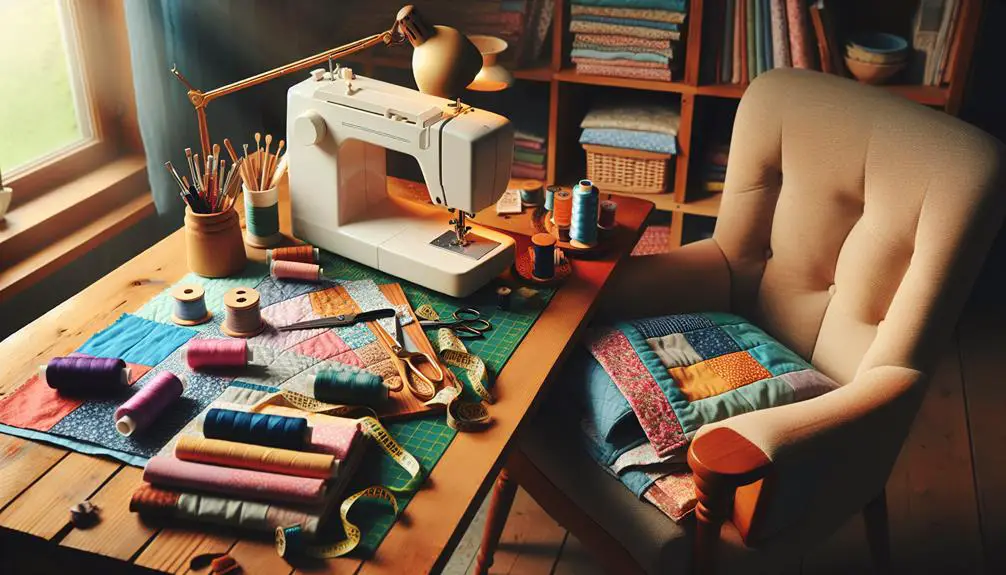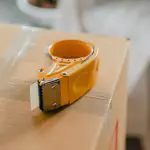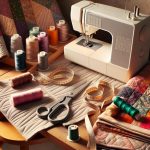It's no coincidence that you stumbled upon DIY fabric projects just as you're looking for a new creative outlet. Starting with the right tools like fabric scissors and measuring tape can make all the difference in your projects. You'll find that selecting the perfect fabric and mastering some basic sewing techniques are essential steps. But what if you don't want to sew at all? There are plenty of no-sew options to explore. Imagine the satisfaction of creating your own custom pillowcases or tote bags. Ready to discover more about these creative possibilities?
Table of Contents
Key Takeaways
- Start with basic sewing techniques like hand stitching, machine sewing, and seam finishing.
- Choose appropriate fabrics for your projects including cotton, denim, and linen.
- Explore no-sew projects such as fabric painting, embroidery with iron-on patterns, and applique.
- Personalize simple projects like pillowcases and tote bags using fabric painting and embellishments.
- Maintain your fabrics by addressing stains promptly and storing them in breathable fabric bags in a cool, dry place.
Essential Tools and Materials
To kick-start your DIY fabric projects, you'll need a well-stocked toolkit with essential supplies like fabric scissors, measuring tape, and sewing needles. Mastery begins with the right tools, so don't skimp on quality. Precision in fabric cutting is vital; invest in sharp, dedicated fabric scissors. Avoid using these scissors for other materials to maintain their effectiveness.
Next, a reliable measuring tape is indispensable. Accurate measurements guarantee your projects fit perfectly, so choose a flexible, durable tape that won't stretch over time. Pair it with a clear, sturdy ruler for straight, clean cuts.
Organization is key to efficient sewing. Implement a fabric storage system that keeps your materials visible and accessible. Use clear bins or labeled shelves to categorize fabrics by type, color, or project. This not only saves time but also keeps your workspace tidy and inspires creativity.
Sewing needles come in various sizes and types. Stock a variety to handle different fabrics and techniques. Whether you're hand-stitching or using a sewing machine, the right needle makes a difference in the quality of your stitches.
Choosing the Right Fabric
Once you've gathered your tools, the next step is selecting the right fabric for your project. This choice can make or break the outcome of your DIY endeavor. Start by considering fabric weights. Light fabrics like cotton or linen are perfect for summer garments, while heavier fabrics like wool or denim are ideal for winter wear. Knowing the weight helps you understand how the fabric will drape and feel.
Fabric patterns are another critical factor. Patterns can add personality and interest to your project. Stripes, florals, and geometric designs can transform a simple piece into something extraordinary. When selecting a pattern, think about how it aligns with your vision and whether it complements the item you're creating.
Here's a quick reference table to help you make informed decisions:
| Fabric Type | Weight | Ideal Projects |
|---|---|---|
| Cotton | Light | Shirts, dresses, quilting |
| Denim | Heavy | Jeans, jackets, bags |
| Linen | Medium | Trousers, skirts, home decor |
Basic Sewing Techniques
Mastering a few basic sewing techniques will set you on the path to creating successful DIY fabric projects. Start with hand stitching basics, such as the running stitch, backstitch, and whipstitch. These foundational stitches are essential for mending, creating seams, and adding decorative elements. Practice these stitches on scrap fabric until you're comfortable with your precision and speed.
Next, focus on developing your machine sewing skills. Familiarize yourself with your sewing machine's functions, including threading the needle, winding the bobbin, and adjusting tension. Begin with straight stitches and gradually incorporate zigzag stitches. Consistency is key; make sure your stitches are even and secure, as this will impact the durability of your projects.
Understanding seam finishing techniques is important for a polished look. Learn to sew French seams, serge edges, or use pinking shears to prevent fraying. These methods will give your projects a professional finish and extend their lifespan.
Hemming tricks are also essential. Master techniques like the double-fold hem and blind hem. These will help you create clean edges on garments, curtains, and other fabric items. With these skills in hand, you're well-equipped to tackle any DIY fabric project with confidence and finesse.
No-Sew Projects
No-sew projects are perfect if you're looking for easy fabric crafts that don't require a needle and thread.
You can create quick home decor items or simple fashion accessories in no time.
Ready to explore some fun and hassle-free ideas?
Easy Fabric Crafts
Creating beautiful fabric crafts doesn't require sewing skills, and you can make impressive projects with just a few simple supplies. Begin with fabric painting; it's an excellent way to personalize your creations. Using fabric paint and stencils, you can add intricate designs to everything from tote bags to pillowcases.
If you're interested in a more detailed approach, try embroidery. Pre-made iron-on patterns make it easy to embellish fabrics without the need for advanced stitching techniques.
Now, let's talk about quilting. You might think quilting is only for seasoned crafters, but you can create quilt-like effects using fabric glue and pre-cut fabric squares. Simply arrange your squares on a backing fabric and glue them in place, mimicking traditional quilting patterns.
Applique is another fantastic no-sew option. Cut out shapes from colorful fabric scraps and use fabric glue to attach them to a base fabric, creating eye-catching designs with minimal effort.
These easy fabric crafts allow you to explore different techniques and materials without the need for a sewing machine. Immerse yourself and discover how rewarding fabric crafting can be, even without sewing a single stitch.
Quick Home Decor
Transforming your living space can be effortless and fun with these quick no-sew home decor projects. Whether you're looking to refresh a room or create a heartfelt gift, these ideas are perfect for beginners and pros alike.
First, consider making quick curtains. Simply choose a fabric that complements your room, measure the window, and use fabric glue or iron-on tape to hem the edges. Attach clip-on curtain rings and hang them up for an instant upgrade.
Fast table runners are another easy project. Select a fabric that matches your dining area, cut it to the desired length, and finish the edges with fabric glue. Your dining table will look stylish and inviting in no time.
Unique wall art can also be achieved without sewing. Stretch fabric over a canvas frame, secure it with a staple gun, and voilà—your own custom artwork!
For creative gifts, think about making fabric-covered photo frames or decorative pillows using the same no-sew techniques. They're thoughtful and personal, perfect for any occasion.
Here's a quick look at how these projects can transform your space:
| Project | Impact |
|---|---|
| Quick Curtains | Cozy and customized |
| Fast Table Runners | Elegant dining setup |
| Unique Wall Art | Personalized ambiance |
| Creative Gifts | Heartfelt and unique |
Simple Fashion Accessories
With just a few basic materials, you can craft stylish fashion accessories that require no sewing skills at all. Imagine sporting a chic fabric headband that you've designed yourself. Simply cut a strip of fabric, twist it into a knot, and secure the ends with fabric glue. Voilà – you've got a custom accessory!
You can also create stylish bows to clip onto bags or shoes. Cut two rectangles, pinch the center, and wrap another small piece around it. Secure with glue, and you're done.
For a bit more flair, try making DIY fabric belts. Choose a durable fabric, cut to your desired length, and attach D-rings to one end using fabric glue. Wrap it around your waist, thread through the D-rings, and you've got a bespoke belt that adds a personal touch to any outfit.
Trendy wristlets are another fantastic project. Cut a strip of fabric, fold it in half, and glue the edges together, leaving a small loop for a clasp or button. These wristlets can be adorned with beads or charms, turning a simple piece of fabric into a fashionable statement piece.
Simple Pillowcases
Making simple pillowcases is a great way to add a personal touch to your bedroom decor. Start by selecting a fabric that complements your existing color scheme. Once you've chosen your fabric, consider embellishing it with fabric painting or embroidery. These techniques allow you to create unique designs and patterns that reflect your style. For fabric painting, use stencils or freehand designs. Embroidery, on the other hand, can add intricate details and textures, elevating the overall look.
If you're interested in more advanced techniques, try incorporating patchwork or applique. Patchwork involves sewing together different fabric pieces to create a colorful, patterned look. Applique, where you sew smaller pieces of fabric onto a larger base fabric, can add dimension and visual interest. Both techniques offer endless possibilities for customization.
To construct your pillowcase, measure your pillow and add seam allowances before cutting your fabric. Sew the pieces together with a straight stitch, ensuring all seams are secure. Turn the pillowcase right side out and give it a good press with an iron. Slip your pillow inside, and admire your handiwork. With these methods, your pillowcases will be both functional and artistic.
Custom Tote Bags
When creating your custom tote bag, start by selecting the right fabric material that suits your style and needs.
Next, familiarize yourself with basic sewing techniques to guarantee your tote is durable and well-made.
Choosing Fabric Material
Selecting the right fabric for your custom tote bags can make a significant difference in both durability and style. When choosing fabric material, consider three pivotal aspects: fabric textures, color choices, and weight.
- Fabric Textures:
Different textures offer varying levels of durability and aesthetic appeal. For a sturdy tote, canvas and denim are excellent choices. If you're aiming for a more fashionable look, consider using cotton or linen blends. Each texture not only impacts the bag's longevity but also its tactile feel and visual appeal.
- Color Choices:
The color of your fabric is just as important as its texture. Neutral colors like beige, gray, and black are versatile and timeless, making them suitable for everyday use. If you want your tote to stand out, opt for vibrant hues or patterned fabrics. Remember, the color can also reflect your personal style and the bag's intended use.
- Weight:
The weight of the fabric will influence how much the tote can carry. Lighter fabrics like cotton are perfect for lightweight items, whereas heavier fabrics like canvas are better for carrying books or groceries. Always match the fabric weight to the bag's intended function.
Sewing Techniques Overview
Mastering a few essential sewing techniques will enhance the quality and durability of your custom tote bags. Begin with fabric manipulation; understanding how to handle different types of fabric is pivotal. For instance, lightweight cotton requires a gentler touch than sturdy canvas. Use pins and clips to keep your fabric pieces aligned and prevent shifting during the sewing process.
Next, familiarize yourself with decorative stitches. These stitches not only add visual appeal but also reinforce the seams, making your tote bag more resilient. Practice a variety of decorative stitches on scrap fabric to see how they look and feel before applying them to your project.
Embellishments can elevate your tote bag from simple to stunning. Consider using beads, buttons, or patches to add a unique flair.
If you're looking to incorporate more intricate designs, explore applique techniques. Applique involves sewing pieces of fabric onto a larger piece to create patterns or images, offering endless possibilities for customization.
Personalizing Your Tote
Adding personal touches to your custom tote bag transforms it from a basic accessory into a unique expression of your style. You can take simple steps to elevate your tote into a masterpiece that showcases your creativity and flair.
- Fabric Painting and Embellishment: Start by using fabric paint to create designs or patterns on your tote. Whether you prefer abstract art or intricate designs, fabric painting offers endless possibilities. To enhance your painted designs, consider adding embellishments like beads, sequins, or patches. These small details can make a big impact and give your tote a sophisticated look.
- Monogramming: Adding your initials or a special monogram can make your tote truly personal. You can stitch your monogram directly onto the fabric or use iron-on letters. Monogramming adds a touch of elegance and makes your tote uniquely yours.
- Decoupage: This technique involves gluing paper cutouts onto your tote and sealing them with a clear adhesive. Choose images or patterns that speak to you, and let your tote become a canvas for your favorite visuals. Decoupage allows you to incorporate a mix of textures and colors, resulting in a one-of-a-kind accessory.
Easy Fabric Banners
Creating easy fabric banners is a fantastic way to add a personalized touch to any event or space. Start by gathering your materials: fabric scraps, scissors, a ruler, and some twine or ribbon. For a cohesive look, choose fabrics that complement each other in color and pattern.
First, decide on the size and shape of your banner pieces. Common shapes include triangles, rectangles, and even pennants. Cut your fabric accordingly, making sure each piece is uniform.
To create fabric garlands, simply fold the top edge of each fabric piece over the twine or ribbon, securing it with fabric glue or a quick stitch. Space them evenly for a polished look.
Next, let's get creative with DIY fabric flags. These are perfect for adding text or symbols to your banner. Use fabric markers or paint to write celebratory messages or draw designs that resonate with the theme of your event. Once decorated, attach these flags to your banner string in the same manner as the garlands.
Handmade Scrunchies
Handcrafted scrunchies are a fun and simple way to add a pop of color to your wardrobe. They're not just practical hair accessories; they're also a great way to showcase your unique style. By selecting different fabric patterns and experimenting with dyeing techniques, you can create scrunchies that stand out.
To get started, you'll need a few basic supplies and a bit of patience:
- Fabric and Dye: Choose a fabric that appeals to you. Cotton works well for beginners. If you're feeling adventurous, try dyeing the fabric to create custom colors and patterns.
- Elastic: Use a strong, stretchy elastic to guarantee your scrunchie holds up over time.
- Sewing Tools: A needle and thread or a sewing machine will be necessary to stitch everything together.
Creating your own scrunchies allows you to stay ahead of hair accessory trends and personalize your look. Whether you prefer bold prints or subtle hues, the options are endless.
Immerse yourself in the world of fabric patterns and dyeing, and you'll discover just how versatile and enjoyable making handmade scrunchies can be.
Upcycling Old Clothes
Transforming old clothes into new treasures is a fantastic way to give your wardrobe a fresh, eco-friendly update. Instead of tossing those outdated or worn-out garments, you can breathe new life into them with some creative ideas and a bit of effort.
Start by exploring fabric painting. This technique allows you to add bold patterns or subtle designs to your clothes, making each piece uniquely yours. Use stencils for precise shapes or freehand for a more personal touch.
Next, consider embroidery. This timeless craft can elevate even the simplest of fabrics with intricate designs and vibrant colors. You can embroider floral patterns, geometric shapes, or even your initials for a personalized touch. If you're feeling adventurous, mix embroidery with fabric embellishments like beads, sequins, or patches. These elements can add texture and dimension to your creations, making them stand out.
Don't forget about repurposing larger items. Turn an oversized shirt into a chic dress or a pair of jeans into a trendy tote bag. The possibilities are endless, and each project you undertake will sharpen your skills, giving you mastery over the art of upcycling.
Care and Maintenance Tips
Proper care and maintenance are necessary to ensure your DIY fabric projects stay looking their best for years to come. By mastering a few key techniques, you can keep your creations pristine and fresh.
Let's jump into some essential tips:
Stain Removal: Address stains promptly to prevent them from setting. Use a fabric-safe stain remover and gently blot the area. For tougher stains, a mixture of baking soda and water can work wonders. Always test on a small, inconspicuous area first.
Ironing: Ironing not only smooths out wrinkles but can also strengthen seams and hems. Use the appropriate heat setting for your fabric type and always iron on the reverse side to avoid damaging delicate surfaces. Consider using a pressing cloth to protect your fabric.
Storage Techniques: Proper storage is vital for maintaining the shape and color of your projects. Store your items in a cool, dry place away from direct sunlight. Use breathable fabric bags to prevent dust accumulation and avoid plastic bags, which can trap moisture and lead to mildew.
Frequently Asked Questions
How Do I Store Leftover Fabric Scraps Effectively?
Ever wondered how to keep your fabric scrap organization on point? Sort by size and color, store in clear bins, and label. You'll have efficient storage and easy access for creative fabric remnants in eco-friendly projects.
Can I Use Fabric Glue Instead of Sewing for All Projects?
You can't use fabric glue for all projects. Consider fabric glue alternatives, like fusible tape, for strength. Pros and cons of no sew fabric projects include quick assembly but less durability compared to traditional sewing methods.
What Are Some Beginner-Friendly Online Fabric Stores?
For fabric sourcing, check out budget-friendly options like Joann Fabrics, Fabric.com, and Spoonflower. They offer beginner-friendly fabric types such as cotton and flannel, making them the best choices for your first projects.
How Do I Choose the Right Thread Color for My Fabric?
Did you know 80% of sewing professionals use color theory to match thread? Consider your fabric texture and whether you want matching or contrasting thread. Mastering this can elevate your projects, making them look professionally finished.
Are There Any Mobile Apps for Planning and Designing DIY Fabric Projects?
Yes, there are several mobile apps for planning and designing fabric projects. These apps provide fabric project inspiration and help with fabric project organization. Try apps like Sew Organized, Quiltography, or Pattern Keeper for efficient planning.
- Tetron Fabric for Marine Applications: Durability and Use Cases - June 18, 2025
- Tetron Fabric for Outdoor Furniture: Weather Resistance and Care - June 18, 2025
- Tetron Fabric for Wall Coverings: Style and Application Tips - June 18, 2025






